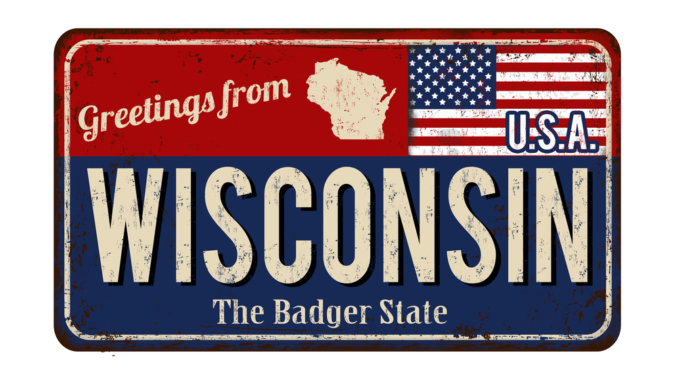“On Wisconsin!”
LISTEN ON SOUNDCLOUD:
Thirtieth to join the United States, Wisconsin, known as “The Badger State,” ratified the U.S. Constitution May 29, 1848. The Wisconsin State Constitution currently in use was adopted in 1848.
“On Wisconsin!” were words exclaimed by Arthur MacArthur Jr. at the Battle of Chattanooga in 1863 urging his fellow Badgers on during an important phase of the battle for which he was awarded the Congressional Medal of Honor. The state’s official slogan is “Forward!” which embodies the spirit of LTG MacArthur and the spirit of the people who live here today. Citizens of Wisconsin are always looking to innovate, expand and advance, but they are appreciative of their past as well.
Wisconsin received its name from the river that runs through the center of the state named by the Miami Indians. The word “Wisconsin” means “river running through a red area” and may possibly refer to the beautiful red bluffs located near today’s city of Wisconsin Dells. For 10,000 years, Wisconsin has also been home to various Native American tribes including the Oneida, Chippewa, Menominee, Ho-Chunk, Sauk and Mahican.
In 1634, European explorer Jean Nicolet was the first European to have landed in Wisconsin near the present city of Green Bay. The French attempted to colonize the area and operated a very successful fur trade in Wisconsin. The French established a military and commercial presence in Wisconsin until after the French and Indian War, when the Great Britain assumed control of the area. The U.S. acquired what is today Wisconsin after the Treaty of Paris in 1783, ending the American Revolution.
In 1836, the Wisconsin Territory was organized and the first territorial legislature met in Belmont, Wisconsin. In 1848, Wisconsin was admitted to the Union as the 30th state with Madison being designated as its capital city.
The Wisconsin Constitution was written at the state’s Constitutional Convention in Madison in December of 1847 and was approved by the citizens of Wisconsin Territory in 1848. This original Constitution has been amended over 100 times but is still in use today, making it the oldest state constitution outside of the New England states. At first, the Wisconsin Constitution granted suffrage to white male citizens over 21 and to Native Americans who were citizens of the United States but it did allow suffrage to change over time as the state legislature intended it to. The banking industry was very controversial in Wisconsin at this time and the idea of the state chartering a bank was voted on at the same time as the state Constitution was ratified. With this vote, the citizens of Wisconsin allowed the state to charter banks within its borders.
Today’s Wisconsin Constitution consists of a Preamble, thanking Almighty God for the freedoms that citizens of the state are blessed with, and then 14 Articles. The first article is a general declaration of rights as citizens of Wisconsin. This allows Wisconsin citizens to live under the same freedoms as the United States Bill of Rights, to prohibit prison sentences for debt, place military under the control of civil authorities, and guarantees our citizens the right to fish and hunt.
The Wisconsin State Legislature is described in Article Four of the state Constitution and is a bicameral lawmaking body comprised of the Wisconsin State Assembly and Wisconsin State Senate. The 4th Article allow states how state representatives are elected and sets forth the powers and limitations of our state legislature.
Article Five establishes the Legislative Branch in Wisconsin. The state’s executive branch consists of a governor and a lieutenant governor, who are each elected to serve four year terms. The powers and duties of the state executive are also outlined here as well, including the line-item veto over appropriation bills. The succession chain of governance is also outlined here, should the governor resign, be recalled or pass away.
The Judicial branch is established in Article Seven and grants the state a Supreme Court, composed of seven Justices, each holding 10-year terms. The Constitution also creates the Wisconsin Circuit Court system, as well as the Wisconsin Court of Appeals. The state may also set up courts and jurisdictions over cities, towns and villages within the state. The impeachment process of state officials is outlined here as well.
The original Wisconsin Constitution document is unfortunately missing and the copy on display in our state capitol building is a replica. The original may have been sent to a publisher and lost somewhere along the way. Fortunately for the citizens of Wisconsin, the words and ideas embodied within the document still exist and will endure far into the future. On Wisconsin!
Val Crofts is a Social Studies teacher from Janesville, Wisconsin. He teaches at Milton High School in Milton, Wisconsin and has been there 16 years! He teaches AP U.S. Government and Politics, U.S. History and U.S. Military History. Val has also taught for the Wisconsin Virtual School for seven years, teaching several Social Studies courses for them. Val is also a member of the U.S. Semiquincentennial Commission celebrating the 250th anniversary of the Declaration of Independence and is honored to participate in this Study on the States!
Click Here for the next essay.
Click Here for the previous essay.
Click Here to have the NEWEST essay in this study emailed to your inbox every day!
Click Here to view the schedule of topics in our 90 Day Study on Congress.




My Home State, Wisconsin. ON WISCONSIN! GO BADGERS!! Thank you!
My pleasure and I’m glad you liked it!
My friends is a Badger. He and twin brother [both 7’2″] played basketball for the Wisconsin. I believe his number was 54 and his brothers was 45.
Thank you for telling us about Wisconsin.
PSD